Spermatophores should be evacuated periodically
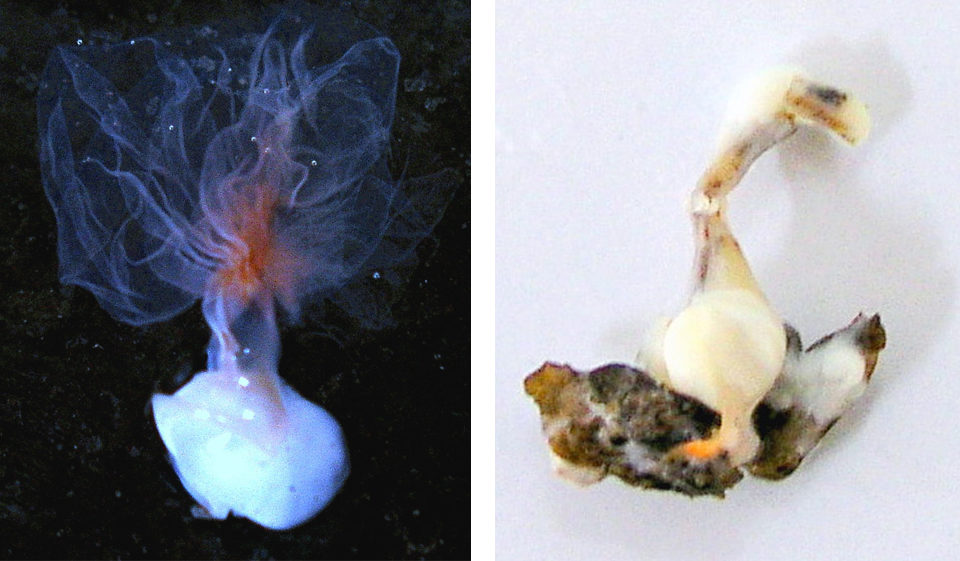
Reproduction is a main area where science can contribute to the growth of aquaculture and provide effective solutions for industry problems. Thus, many research projects have focused on the reproductive biology of farmed species. However, most researchers focused on female reproduction – possibly due to the obvious reproductive dysfunction of females under captivity.
In female shrimp, vitellogenesis and oocyte maturation are processes that demand high levels of energy. Conversely, in males, sperm production is believed to consume less energy. Males use up more energy for sex competition and female guarding. Yet male-related reproductive dysfunction and infertility have been increasingly reported in commercial maturation facilities.
The authors recently carried out a series of studies at the experimental shrimp hatchery facility of the Central Institute of Brackishwater Aquaculture to characterize the reproductive capability of male black tiger shrimp, Penaeus monodon, by documenting changes in sperm quality in relation to consecutive regeneration, molting cycle and length of rearing period.
Experimental setup
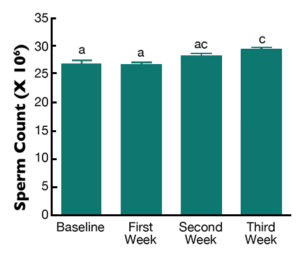
Thirty broodstock-sized P. monodon males were obtained from the broodstock fishery along the coast of Chennai, Tamil Nadu, India. The animals were tagged and reared in the experimental hatchery. Baseline sperm quality characteristics – sperm count, proportion of live sperm and percentage of abnormal sperm – were obtained from freshly extracted spermatophores.
Spermatophore data and the general condition of the animals were recorded at weekly intervals for 15 animals. The other shrimp remained intact without periodic manual ejaculation. The spermatophores were collected and evaluated on day 30. Further sperm quality was also evaluated at postmolt, intermolt and premolt phases of molting cycle.
Sperm quality variables
While spermatophore weights remained unaffected by consecutive regeneration, sperm count and proportion of viable sperm were better in the subsequent regenerated spermatophores compared to the baseline values (Fig. 1). Further, melanization of spermatophore/male reproductive tracts was not observed. On the contrary, the large proportion of shrimp kept intact without removal of spermatophores developed melanization.
The quality of the melanized spermatophores was extremely poor when compared to the quality of the non-melanized spermatophores (Fig. 2). Histological examination of melanized terminal ampules and testes showed clumps of sperm with melanized debris.
Molt cycle
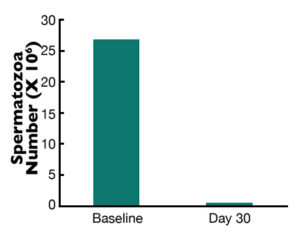
Spermatogonia, spermatocytes and spermatids were found in all the phases of the molt cycle. However, only one type of spermatogenic cells was found at any one time. This indicated synchrony in the sperm production. It is also found that the sperm production was a continuous process over the molt cycle (Fig. 3).
Conversely, spermatophore concentration varied during the different molt phases, with significantly higher numbers during the premolt phase. New spermatophores appeared after the exuviations of old exoskeleton.
Perspectives
As suggested by S. Parnes and co-workers in 2006, spermatophores have an inherent “expiration date” and therefore should be evacuated periodically. In the wild, the renovation of spermatophores is carried out by molting or mating. Under captive conditions, mating opportunities and molting frequencies vary.
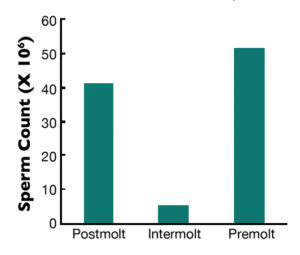
of Penaeus monodon at different phases
of the molt cycle.
In the absence of receptive females or failure in molting, the normal renovation of spermatophores does not take place, and they eventually degrade or melanize. Melanization is an end result of prophenoloxidase activation, which is triggered in response to foreign agents such as bacteria, fungi or multicellular parasites, or as a result of tissue damage. Periodic spermatophore renovations by artificial ejaculation are a practical procedure for improving sperm quality in P. monodon, as reported in Litopenaeus shrimp species.
Sperm quality was found to be highest during the premolt stage, which corresponds to the elevated titre of the molting hormone ecdysteroid. The stimulatory effect of the ecdysteroid on testicular activity of crustaceans has been reported by A. Sagi and co-workers in 1991. The present study indicated that for breeding programs, males at the premolt stage may provide better results than shrimp in other stages.
Editor’s Note: Full references are available from the first author.
(Editor’s Note: This article was originally published in the July/August 2012 print edition of the Global Aquaculture Advocate.)
Authors
-
Dr. C.P. Balasubramanian
Central Institute of Brackishwater Aquaculture
75 Santhome High Road
R. A. Puram
Chennai 600 028 India -
Dr. P. Ravichandran
Central Institute of Brackishwater Aquaculture
75 Santhome High Road
R. A. Puram
Chennai 600 028 India -
D.L. Mohanlal
Central Institute of Brackishwater Aquaculture
75 Santhome High Road
R. A. Puram
Chennai 600 028 India -
Dr. S.M. Pillai
Central Institute of Brackishwater Aquaculture
75 Santhome High Road
R. A. Puram
Chennai 600 028 India -
Dr. A.G. Ponniah
Central Institute of Brackishwater Aquaculture
75 Santhome High Road
R. A. Puram
Chennai 600 028 India
Tagged With
Related Posts

Responsibility
A look at various intensive shrimp farming systems in Asia
The impact of diseases led some Asian shrimp farming countries to develop biofloc and recirculation aquaculture system (RAS) production technologies. Treating incoming water for culture operations and wastewater treatment are biosecurity measures for disease prevention and control.
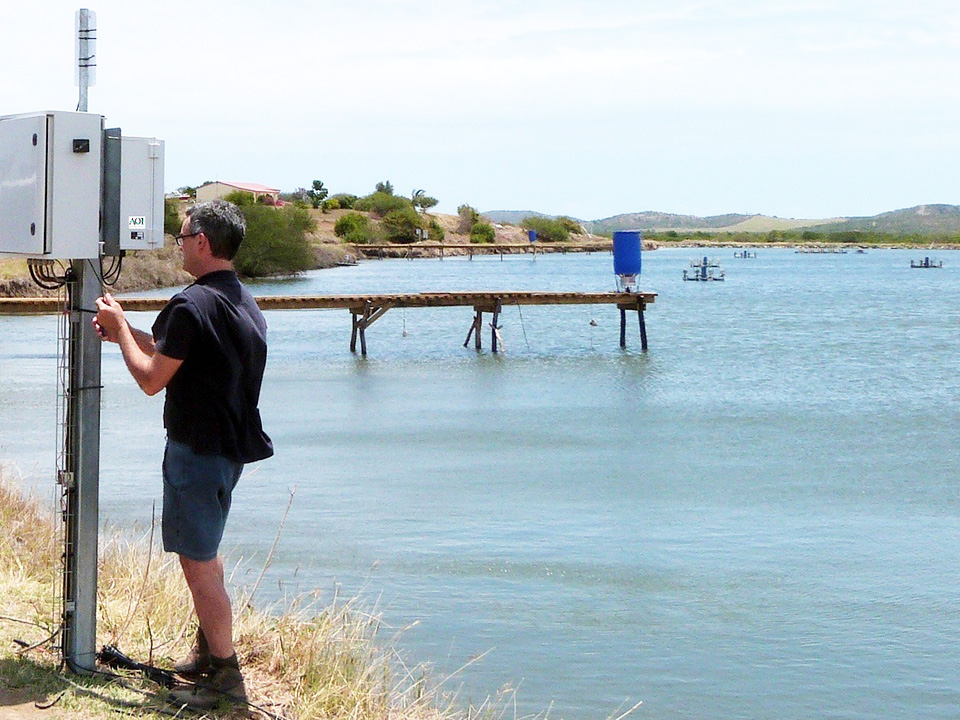
Innovation & Investment
Acoustic control improves feeding productivity at shrimp farms
In systems recently developed for shrimp farms, passive acoustic-based technology enables sensor-based control of multiple automatic feeders. Improved growth and feed conversion have been recorded at commercial farms using the technology.

Health & Welfare
Ammonia toxicity degrades animal health, growth
Ammonia nitrogen occurs in aquaculture systems as a waste product of protein metabolism by aquatic animals and degradation of organic matter, or in nitrogen fertilizers. Exposure can reduce growth and increase susceptibility to diseases in aquatic species.
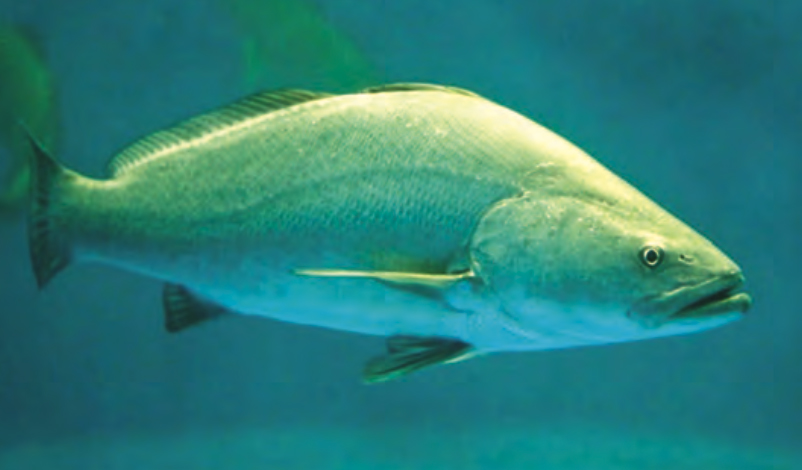
Responsibility
Aquaculture gives endangered totoaba a fighting chance
The tenuous fate of a pint-sized porpoise, the critically endangered vaquita, is linked to a fish targeted by poachers fueling China’s appetite for maws. The vaquita remains in peril, but aquaculture presents some hope for the totoaba.


